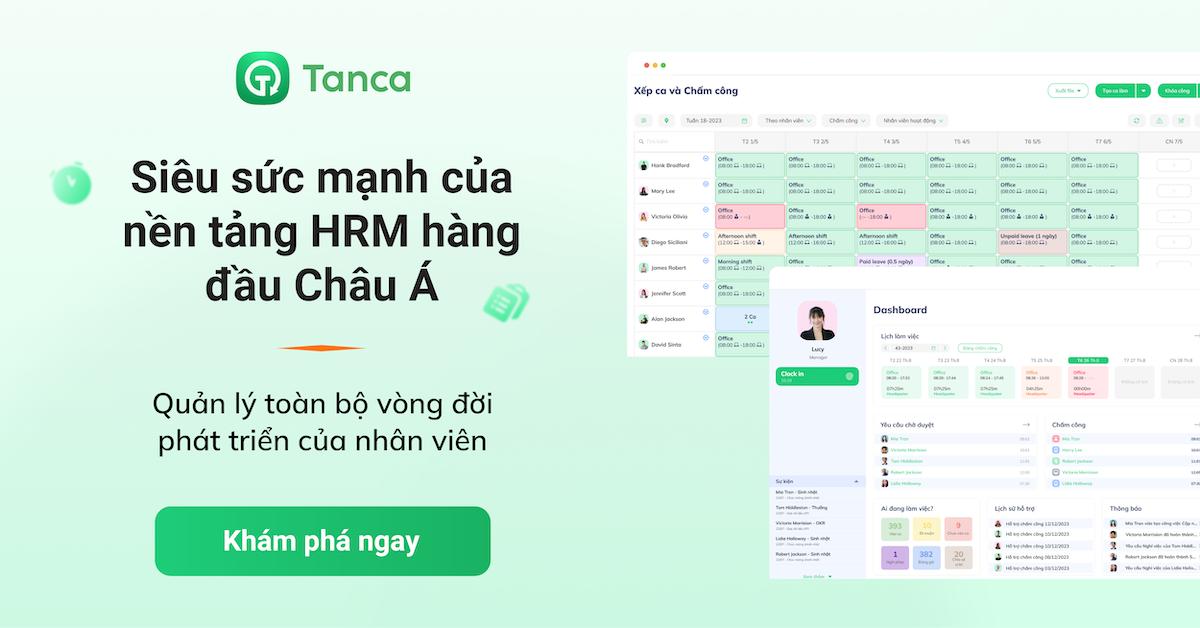Onboarding remote employees has become increasingly important as the workforce landscape continues to shift towards remote and hybrid models. Recent figures indicate that as of 2023, 12.7% of full-time employees work from home, while 28.2% operate in a hybrid model. This trend is expected to grow, with projections suggesting that by 2025, 32.6 million Americans (about 22% of the workforce) will be working remotely.
Given these statistics, it's clear that HR professionals must prioritize effective remote onboarding strategies to ensure new hires feel connected, engaged, and prepared for their roles. A well-executed remote onboarding process can significantly enhance employee retention and productivity, making it a crucial aspect of modern HR practices.
This post, Tanca will bring you details of checklists and tips that help HR create a seamless and engaging remote onboarding experience.
What Is Remote Employee Onboarding?

Remote employee onboarding is the process of integrating new employees into a company's culture, policies, and procedures without requiring them to be physically present at the workplace. This process is designed to help new hires feel welcomed, supported, and prepared to perform their job duties effectively, despite the physical distance.
To conduct remote employee onboarding efficiently, HR should answer the following questions:
- What are the essential tasks and responsibilities of the new hire's role?
- What are the necessary tools and resources required for the new hire to perform their job duties?
- How will the new hire be introduced to the team and integrated into the company culture?
- What is the plan for ongoing support and feedback for the new hire?
By answering these questions, HR can create a comprehensive remote employee onboarding plan that sets new hires up for success and helps them feel valued and supported from the start.
Read more:
Remote Onboarding Challenges - A Guide for HR Professionals

Remote onboarding presents unique challenges that can significantly impact the integration and productivity of new hires. Understanding these challenges and implementing effective strategies can help HR professionals create a seamless onboarding experience. Here are the primary challenges and actionable solutions:
1. Technological Barriers
Challenge:
New hires often need to set up their equipment and access essential systems on their own, which can be overwhelming and time-consuming.
Solution:
- Pre-Setup: Ensure all necessary equipment is delivered before the start date.
- IT Support: Provide detailed written instructions and schedule an IT session on the first day to assist with setup and troubleshooting.
- Checklists: Use self-onboarding checklists to streamline the process and ensure all steps are completed.
2. Limited Personal Interaction
Challenge:
Remote onboarding lacks face-to-face interaction, making it harder for new employees to build relationships and feel connected to the company culture.
Solution:
- Virtual Meet-and-Greet: Schedule virtual meet-and-greets and regular one-on-one meetings to foster connections.
- Buddy System: Assign a buddy or mentor to provide peer support and regular communication.
- Team Building: Organize virtual team-building activities and social events to encourage bonding.
3. Cultural Assimilation
Challenge:
Integrating new hires into the company culture can be difficult without physical presence, leading to feelings of isolation and disengagement.
Solution:
- Cultural Activities: Create virtual cultural assimilation activities, such as online team-building events and virtual office tours.
- Company Values: Share information about the company's mission, values, and culture through online presentations or videos.
- Engagement: Encourage participation in virtual events and provide opportunities for networking across the organization.
4. Lack of Hands-On Training
Challenge:
Certain roles require hands-on training, which can be challenging in a remote setting.
Solution:
- Interactive Modules: Develop interactive virtual training modules and assign mentors or trainers to provide guidance.
- Live Demos: Use video conferencing tools for live demonstrations and Q&A sessions.
- Digital Resources: Provide access to digital training materials and resources for self-paced learning.
5. Navigating Virtual Communication
Challenge:
New hires may struggle with remote communication tools and may not know how to communicate effectively with their team.
Solution:
- Tool Training: Provide training on the use of communication tools and set clear expectations for communication channels and protocols.
- Regular Check-Ins: Encourage regular check-ins and feedback sessions to address any issues and provide support.
- Centralized Resources: Create a centralized repository for easy access to important documents and resources.
6. Preventing Information Overload
Challenge:
Managing the flow of information without overwhelming new hires is a common challenge.
Solution:
- Structured Timeline: Structure the onboarding process with a clear timeline and milestones, spreading out information over the first few weeks.
- Centralized Platform: Use a centralized platform to organize and disseminate information, making it easier for new hires to find what they need.
- Balanced Learning: Provide a mix of synchronous and asynchronous learning opportunities to accommodate different learning styles.
Remote Employee Onboarding Checklist

A well-structured remote onboarding process is essential for integrating new hires smoothly and ensuring they feel connected and productive from day one. Here’s a comprehensive checklist for HR professionals to follow:
Pre-boarding (Before the First Day)
- Develop a remote work policy
- Prepare equipment and tools
- Send a welcome package
- Create virtual onboarding materials
- Set up a dedicated onboarding space
First Day
- Welcome and introductions
- Orientation session
- Assign a buddy or mentor
First Week
- Training and resources
- Set clear expectations
- Regular check-ins
First Month
- Goal setting
- Continuous training
- Feedback and improvement
Beyond the First Month
- Regular check-ins and support
- Encourage social interaction
- Monitor progress and performance
Learn more about our virtual onboarding process and practices.
Best Tips For Engaging Remote New Hires

Engaging remote new hires effectively is crucial for their integration and long-term success within the company. Here are the top 12 detailed tips to ensure a smooth and engaging onboarding process:
1. Develop a Remote Work Policy
Develop a clear and detailed remote work policy that outlines communication expectations, work hours, and performance metrics. This policy should cover:
- Communication expectations
- Flexible work hours
- Performance metrics
- Virtual meeting etiquette
Regularly update this policy to reflect changes in the remote work landscape, ensuring it remains relevant and effective.
2. Send Equipment and a Welcome Package
To ensure a seamless start, deliver all essential equipment (laptop, headset, etc.) prior to the employee's first day.
Enhance the welcome experience with a thoughtfully curated package including company swag, a personalized welcome letter, and office essentials. A warm video message from leadership can add a personal touch.
3. Create an Immersive Virtual Onboarding Hub
Create digital copies of essential documents such as the employee handbook, job descriptions, and training materials. Make these materials easily accessible to help new hires get up to speed quickly and understand company policies and culture.
Utilize a mix of tools to facilitate seamless remote work. This may include:
- Video conferencing (e.g., Zoom, Microsoft Teams)
- Project management software (e.g., Asana, Trello)
- Instant messaging platforms (e.g., Slack, Microsoft Teams)
- Virtual whiteboarding tools (e.g., Miro, MURAL)
4. Leverage Technology and Tools
Utilize video conferencing tools like Zoom or Microsoft Teams for virtual meetings and training sessions. These platforms are essential for maintaining face-to-face interactions, which help build relationships and ensure clear communication.
Zoom is renowned for its high-quality video and audio, even in low-bandwidth situations, and offers features like large meeting capacity, whiteboarding, and AI assistance.
Microsoft Teams, on the other hand, integrates seamlessly with the Microsoft 365 suite, providing a comprehensive collaboration hub that includes chat, file storage, and advanced meeting features like background blur and live captions.
Pro tip: Schedule regular video calls for team introductions, training sessions, and check-ins to keep new hires engaged and connected.
5. Set Clear Expectations
Setting clear expectations is crucial for ensuring employees understand their roles, responsibilities, and performance standards. To achieve this, managers should engage in open communication with their team members, using specific questions to guide the conversation.
Here are some example questions to help set clear expectations:
"What do you understand about your key responsibilities to be in this role?" This question allows managers to gauge the employee's current understanding and address any gaps or misalignments.
Follow-up questions might include: "How do you see your work contributing to our team's goals?" and "What specific outcomes do you think we should prioritize in the next quarter?" These questions help employees connect their individual work to broader organizational objectives.
Another effective approach is to use SMART goal-setting questions: "What specific, measurable targets can we set for this project?" or "How will we know when this goal has been successfully achieved?" Additionally, managers should inquire about potential obstacles: "What challenges do you anticipate in meeting these expectations?" and "What resources or support do you need to succeed?" By addressing these aspects, managers can create a shared understanding of expectations and provide the necessary support for employees to meet them.
6. Assign a Buddy or Mentor
Pair new hires with a buddy or mentor who can provide guidance, answer questions, and offer support during the initial onboarding period. A buddy can:
- Answer questions about company culture and processes
- Introduce the new hire to other team members
- Help navigate the company's digital workspace
- Offer insights and tips for success in the role
This helps new hires feel more connected and supported, accelerating their integration into the team.
7. Schedule Regular Check-ins
Organize frequent check-ins, especially during the first few weeks, to address any questions or concerns.
Regular feedback sessions help new hires feel supported and valued, ensuring they are on the right track.
8. Introduce New Hires to the Team
Facilitate virtual meet-and-greet sessions with team members and key stakeholders. This helps new hires build relationships and feel part of the team from the beginning, fostering a sense of belonging.
9. Provide Interactive Training
Offer interactive training modules and live demonstrations to help new hires understand their roles and responsibilities.
Use a mix of synchronous and asynchronous learning opportunities to accommodate different learning styles and ensure comprehensive training.
10. Highlight Remote Employees in Communications
Feature remote employees in internal communications and recognize their achievements. This helps remote workers feel included and valued within the company, boosting their morale and engagement.
11. Prioritize Mental Health and Well-being
Support your remote new hires' well-being by offering:
- Virtual wellness programs
- Access to mental health resources
- Encouragement for regular breaks and time off
- Promotion of work-life balance
Consider using health or productivity apps with social elements to encourage team members to connect and support each other in their wellness journeys.
12. Gather and Act on Feedback
Create a continuous improvement loop to enhance your remote onboarding process:
- Collect feedback through surveys and one-on-ones
- Analyze responses to identify areas for improvement
- Implement changes based on feedback
- Communicate improvements to show you value input
Sample Virtual Onboarding Schedule
Week 1: Welcome and Orientation
Day 1
- 9:00 AM – 10:00 AM: Virtual Welcome Meeting with HR and Direct Supervisor
- 10:00 AM – 11:00 AM: IT Setup and Systems Access Verification
- 11:00 AM – 12:00 PM: Company Overview Presentation
- Break
- 12:30 PM – 1:00 PM: Short Introduction to the Company
- 1:00 PM – 2:00 PM: Virtual Lunch with Team Members
- Break
- 2:30 PM – 4:00 PM: Company Orientation
- 4:00 PM – 4:30 PM: Watch Video Training on Company Culture and Values
- Break
- 4:45 PM – 5:00 PM: Check-In with Welcome Buddy for Q&A (Slack or Zoom)
Day 2-3: You can include details such as those for Day 1
- Company policies and procedures training
- Role-specific software training
- Virtual lunch with team members
Day 4-5
- Department-specific orientation sessions
- Begin role-specific training modules
- End-of-week check-in with supervisor and HR
Week 2: Role Training and Integration
- Continue role-specific training
- Shadow team members virtually
- Attend relevant team meetings
- One-on-one sessions with key collaborators
- Virtual coffee chat with assigned mentor
Week 3-4: Deepening Knowledge and Relationships
- Complete any remaining training modules
- Begin working on initial projects or tasks
- Participate in virtual team-building activity
- Weekly check-ins with supervisor
- Feedback session with HR on onboarding experience
Month 2: Ongoing Development
- Set performance goals with supervisor
- Introduce to company-wide initiatives or projects
- Continue regular check-ins and feedback sessions
- Provide access to additional learning resources
Month 3: Evaluation and Long-term Planning
- Conduct 90-day performance review
- Discuss long-term career development goals
- Gather comprehensive feedback on onboarding process
- Adjust ongoing support and development plan as needed
Conclusion
Onboarding remote employees effectively is essential for integrating new hires into your team and ensuring their long-term success. By creating a comprehensive virtual onboarding program that includes clear communication, structured training, and opportunities for social connection, you can help new employees feel welcomed, informed, and connected to your company culture.
Key strategies include developing an immersive virtual onboarding hub, leveraging technology for seamless communication, setting clear expectations, and providing ongoing support. Remember, the onboarding process is not just a one-time event but an ongoing journey that requires continuous attention and adaptation.
"Successful remote onboarding isn't just about information transfer; it's about creating connections, fostering belonging, and empowering new hires to thrive in a virtual environment."
Tanca hopes you succeed in implementing these strategies to create an exceptional remote onboarding experience for your new hires. A well-executed onboarding process is the first step towards building a strong, engaged, and productive remote workforce. Good luck!











